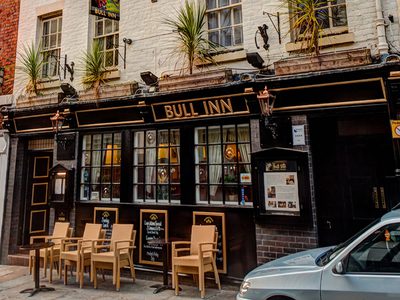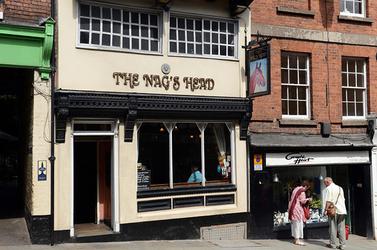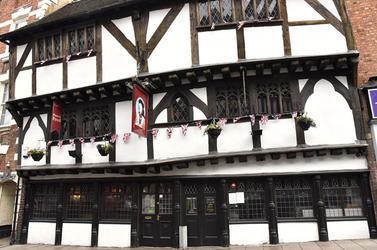- Features
- A guide to Shrewsbury's historic pubs
A guide to Shrewsbury's historic pubs


The Nag's Head
One of Shrewsbury's best-known pubs, The Nags Head dates back to the 16th century. Whilst the building is a classic Tudor timber frame, the front is now hidden behind a stucco facade. The unique side-opening sash windows that grace the front elevation are sandwiched between carved beams, considered to be the finest examples of Tudor carving in Shrewsbury.
Attached to the rear of the pub are the remains of Nags Head House, which dates back to the late medieval period. This structure was moved here in the 1950s.
Some may recognise Nags Head House from A Christmas Carol (1984) which was filmed here in Shrewsbury. It is, according to Scrooge, the “foulest part of the town” and is where the ghost of Christmas Future brings him to watch as his belongings are sold.

The Old Post Office
The Old Post Office, now a Grade II listed hotel, dates back to the 16th century and is the last remaining licensed public house along Milk Street. It has kept the same name throughout its history, having previously been known as “The Old Post Office Inn”.
Names can be misleading, however. This pub's name has nothing to do with the Royal Mail, but refers instead to its history as a 'Posting House'- an inn that provided stabling accommodation for horse-drawn coaches and carts. As late as 1900, The Old Post Office had stabling for up to thirteen horses.

Loggerheads
The Loggerheads is a wonderfully unspoiled, historic pub. Architecturally, little has changed throughout its history. The three-storey building has an 18th-century brick shell which is believed to encase an earlier stone structure from the late medieval period.
Inside, you can find original flagstone flooring and wood panelling. The interior is split into smaller rooms and snugs that retain their historic names, including 'The Gentlemen's Bar' and 'Poet's Corner'.
Believed to have served as a public house since the late 18th century, The Loggerheads has known many names including The Lord Hill, The Greyhound and The Shrewsbury Arms. Now, The Loggerheads refers to the three leopard heads found upon Shrewsbury's coat of arms.

The Bull Inn
The last surviving inn on Butcher Row, The Bull Inn was once one of six public houses that occupied the street: The Tankerville Arms, The Lamb, The Rising Sun, The Cock, The Butcher's Arms and The Bull Inn.
The Bull Inn that we see today was built in the mid 18th century, and had nine rooms, five private and four public, of which three were able to accommodate up to six people.
Now built into the structure of the building, Bull Passage ran alongside the inn, allowing access to five private dwellings at the rear and, behind those, the alms houses which faced towards St Mary's Church.
The original Bull Inn can be dated back to 1624, at least, when it was mentioned in St. Alkmund's Parish Register. It is not known if the current Bull Inn sits on the same plot as the original public house.

The Three Fishes
An attractive Tudor timber-framed building, The Three Fishes sits upon the cobbles of Fish Street, overlooked by the nearby St Alkmund's Church.
There are a number of theories as to how the pub received its unusual name. As the street name suggests, Fish Street was home of Shrewsbury's fish traders and it is thought the pub's name has similar origins. Some believe it takes its name from the emblem of the Abbot of Lilleshall, whose townhouse stood at the corner of Fish Street and Butcher Row and who owned much of the surrounding area. The name could also be a reference to the Bible.
In 1994, The Three Fishes made the news when the landlord at the time, John Sims, declared the pub to be non-smoking - one of the first pubs in the country to implement an outright ban. Sims felt passionately about the cause as his father had died of lung cancer.

The Hole in the Wall
As it stands today, The Hole in the Wall is an amalgamation of two pubs. In 1985 The Hole in the Wall was combined with its neighbour The Market Vaults to create one large establishment.
During renovation works, it was discovered that the cellars for both properties were in fact the remains of a 13th-century manor house. Amongst the debris of the cellar, many historically interesting items were found including clay pipes, pottery and a letter about the Black Death.
A popular watering hole in the 17th-19th centuries, The Hole in the Wall was a favourite with individuals visiting the nearby theatre.
The Market Vaults, then known as The Gut Inn, was popular amongst travelling performers, playing host to Lord Willoughby and his actors troupe in 1527. This was also referred to locally as 'the blood tub'.

Kings Head
Built-in 1404, The Kings Head is a proud, double-jettied, timber-framed building. One of Shrewsbury's oldest public houses, it in fact began life as a draper's house.
During renovations in the 1980s, a painting was discovered on the chimney stack in the main room. The painting is aged and incomplete, so it is not clear if the painting is one large or three smaller scenes; however, the middle section appears to depict The Last Supper. Dated to late Medieval and pre-Reformation, wall paintings like this are incredibly rare. In a first-floor bedroom, they also discovered a priest's hole, inside which was found a bundle of sulphur matches, a scissor-shaped candle trimmer and snuffer, and several clay pipes.
Depicted upon the pub sign is the portrait of King Henry VII, who has an interesting connection with Shrewsbury. Having landed in Pembroke in 1485, Henry, then the Duke of Richmond, needed to cross the Severn on his way to Bosworth. On approach, messengers were sent to Shrewsbury to demand a peaceful entrance, but they found the gates upon Welsh Bridge shut and the portcullis down. Thomas Mytton, the Sheriff of Shrewsbury, refused Henry entry saying, “I recognise no King but Richard” and declaring that Henry would only enter over his “belly” (his dead body). The next day, under encouragement from the townsfolk and on discovering the local lords now supported Henry, Thomas Mytton lay down upon the bridge allowing Henry to step over him into the town. This had the double benefit of allowing the future King access, and Mytton to save face. As The Kings Head sits across from Welsh Bridge, it seems fitting that the pub sign is in the King's likeness.
The original Kings Head stood on the corner of Roushill and Mardol, however ceased trading as a public house in the early 19th century and was later demolished in the 1960s for road widening.
With thanks to John Brown from Shrewsbury Civic Society, who guided us around these historically significant buildings.
Guided tours of Shrewsbury's historic pubs are available through Shrewsbury Civic Society, 01743 344994.
